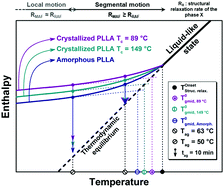当前位置:
X-MOL 学术
›
Soft Matter
›
论文详情
Our official English website, www.x-mol.net, welcomes your
feedback! (Note: you will need to create a separate account there.)
Distinct dynamics of structural relaxation in the amorphous phase of poly(L-lactic acid) revealed by quiescent crystallization
Soft Matter ( IF 2.9 ) Pub Date : 2020/02/25 , DOI: 10.1039/c9sm02541c Xavier Monnier 1, 2, 3, 4, 5 , Nicolas Delpouve 1, 2, 3, 4, 5 , Allisson Saiter-Fourcin 1, 2, 3, 4, 5
Soft Matter ( IF 2.9 ) Pub Date : 2020/02/25 , DOI: 10.1039/c9sm02541c Xavier Monnier 1, 2, 3, 4, 5 , Nicolas Delpouve 1, 2, 3, 4, 5 , Allisson Saiter-Fourcin 1, 2, 3, 4, 5
Affiliation

|
Fast scanning calorimetry (FSC) experiments were performed to investigate physical aging in amorphous and semi-crystalline poly(L-lactic acid)s (PLLAs) that were thermally crystallized under conditions leading to the α′- or α-crystalline form, and either favouring or inhibiting the development of a rigid amorphous fraction (RAF). The enthalpy of recovery was calculated after two procedures of rescaling to the content of the whole amorphous phase and also to the only content of the mobile amorphous fraction (MAF), which helped in clarifying the contribution of the RAF. From the dependence of the structural relaxation rate on the aging temperature, two regimes were evidenced for all samples. In the aging temperature domain situated close to the glass transition, the structural relaxation occurs significantly faster in the MAF. Its rate is independent of the aging temperature and is not influenced by the microstructure. However, the distance to equilibrium is higher in samples for which the coupling is strong between crystal and amorphous, implying that the time to reach equilibrium is also higher. In contrast, at low aging temperatures, for which the whole amorphous phase can be considered as solid, MAF and RAF exhibit the same structrural relaxation rate. This convergence in the relaxation kinetics by decreasing the temperature of physical aging was interpreted as the evolution of relaxation dynamics in the MAF from segmental to local. This change is highlighted by the comparison between MAF and RAF relaxation kinetics, but it occurs similarly in a pure amorphous system.
中文翻译:

静态结晶揭示了聚(L-乳酸)非晶相中结构弛豫的不同动力学
进行了快速扫描量热(FSC)实验以研究无定形和半结晶聚(L在导致α'-或α-结晶形式的条件下热结晶并且有利于或抑制刚性无定形馏分(RAF)的发展的β-乳酸(PLLA)。在将整个无定形相的含量以及可移动的无定形馏分(MAF)的唯一含量重新标定为两个程序之后,计算了回收的焓,这有助于澄清RAF的贡献。从结构弛豫速率对时效温度的依赖性来看,对所有样品都证明了两种方案。在接近玻璃化转变的时效温度域中,MAF中结构弛豫的发生明显更快。其速率与时效温度无关,不受微观结构的影响。然而,在晶体和非晶态之间耦合强的样品中,达到平衡的距离更高,这意味着达到平衡的时间也更长。相反,在较低的老化温度下,对于整个非晶相都可以视为固体,MAF和RAF表现出相同的结构弛豫速率。通过降低物理老化温度而引起的弛豫动力学的这种收敛被解释为MAF中的弛豫动力学从分段到局部的演变。MAF和RAF弛豫动力学之间的比较突出了这一变化,但在纯无定形系统中也类似地发生。对于它的整个非晶相都可以视为固体,MAF和RAF表现出相同的结构弛豫率。通过降低物理老化温度而引起的弛豫动力学的这种收敛被解释为MAF中的弛豫动力学从分段到局部的演变。MAF和RAF弛豫动力学之间的比较突出了这一变化,但在纯无定形系统中也类似地发生。对于它的整个非晶相都可以视为固体,MAF和RAF表现出相同的结构弛豫率。通过降低物理老化温度而引起的弛豫动力学的这种收敛被解释为MAF中的弛豫动力学从分段到局部的演变。MAF和RAF弛豫动力学之间的比较突出了这一变化,但在纯无定形系统中也类似地发生。
更新日期:2020-04-01
中文翻译:

静态结晶揭示了聚(L-乳酸)非晶相中结构弛豫的不同动力学
进行了快速扫描量热(FSC)实验以研究无定形和半结晶聚(L在导致α'-或α-结晶形式的条件下热结晶并且有利于或抑制刚性无定形馏分(RAF)的发展的β-乳酸(PLLA)。在将整个无定形相的含量以及可移动的无定形馏分(MAF)的唯一含量重新标定为两个程序之后,计算了回收的焓,这有助于澄清RAF的贡献。从结构弛豫速率对时效温度的依赖性来看,对所有样品都证明了两种方案。在接近玻璃化转变的时效温度域中,MAF中结构弛豫的发生明显更快。其速率与时效温度无关,不受微观结构的影响。然而,在晶体和非晶态之间耦合强的样品中,达到平衡的距离更高,这意味着达到平衡的时间也更长。相反,在较低的老化温度下,对于整个非晶相都可以视为固体,MAF和RAF表现出相同的结构弛豫速率。通过降低物理老化温度而引起的弛豫动力学的这种收敛被解释为MAF中的弛豫动力学从分段到局部的演变。MAF和RAF弛豫动力学之间的比较突出了这一变化,但在纯无定形系统中也类似地发生。对于它的整个非晶相都可以视为固体,MAF和RAF表现出相同的结构弛豫率。通过降低物理老化温度而引起的弛豫动力学的这种收敛被解释为MAF中的弛豫动力学从分段到局部的演变。MAF和RAF弛豫动力学之间的比较突出了这一变化,但在纯无定形系统中也类似地发生。对于它的整个非晶相都可以视为固体,MAF和RAF表现出相同的结构弛豫率。通过降低物理老化温度而引起的弛豫动力学的这种收敛被解释为MAF中的弛豫动力学从分段到局部的演变。MAF和RAF弛豫动力学之间的比较突出了这一变化,但在纯无定形系统中也类似地发生。











































 京公网安备 11010802027423号
京公网安备 11010802027423号